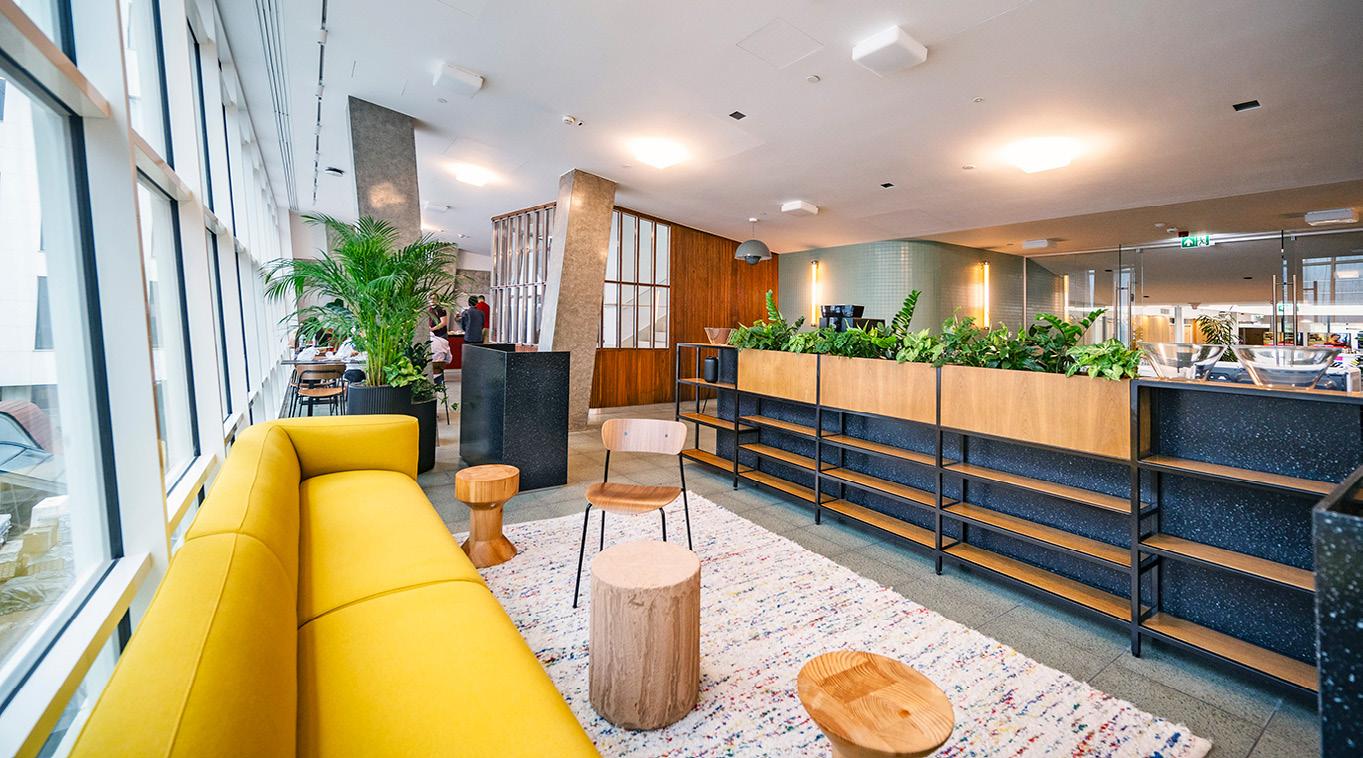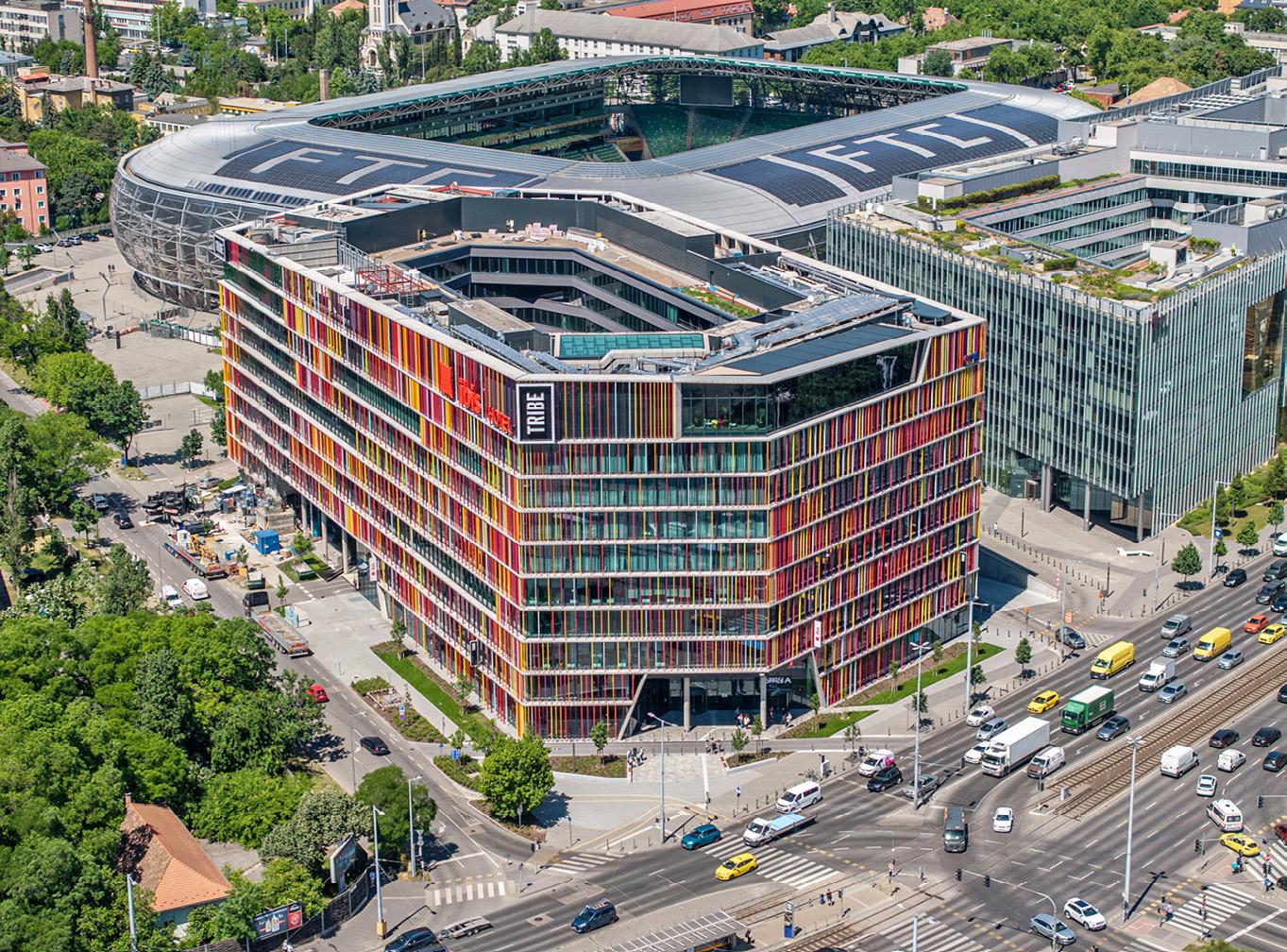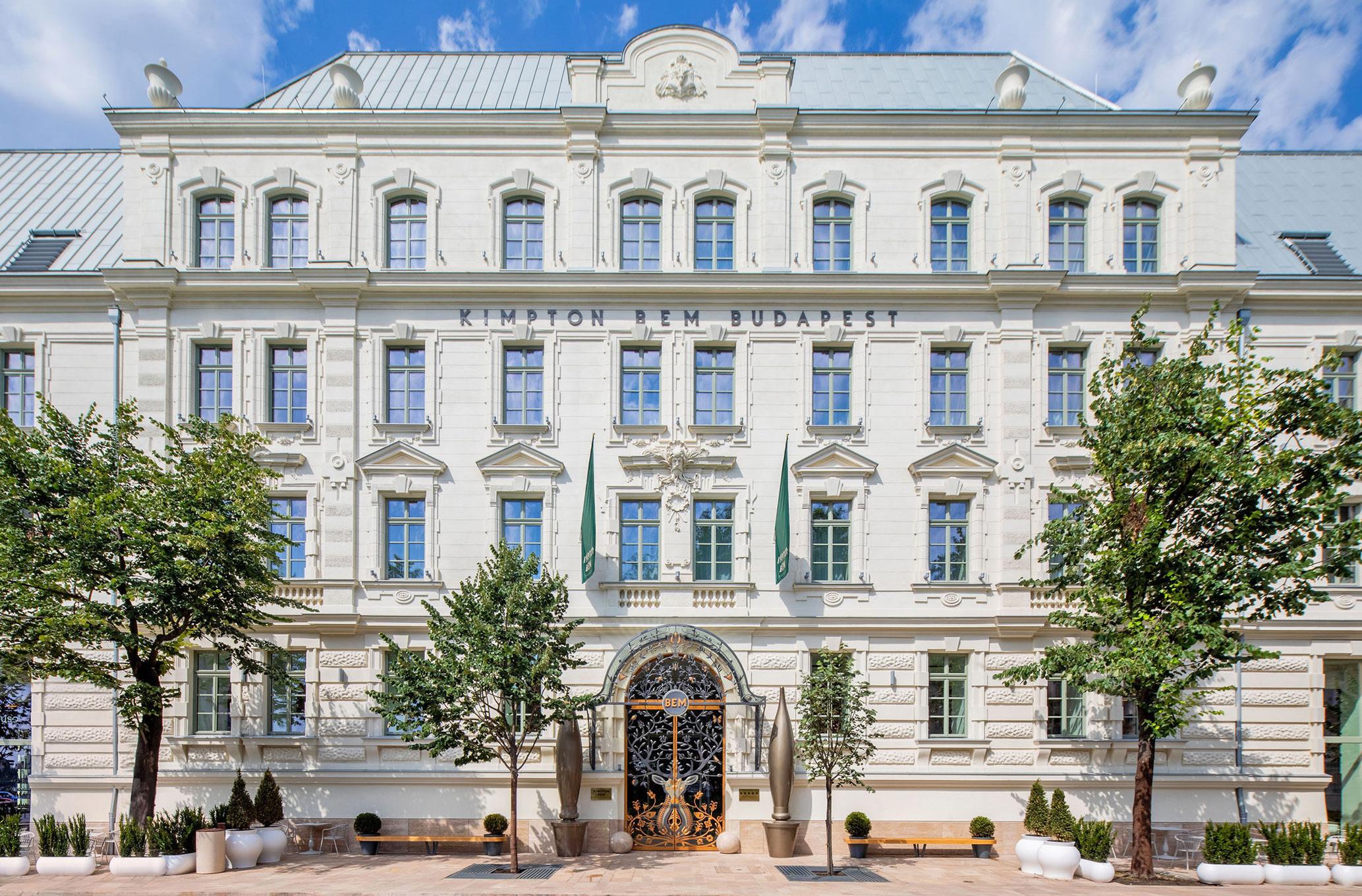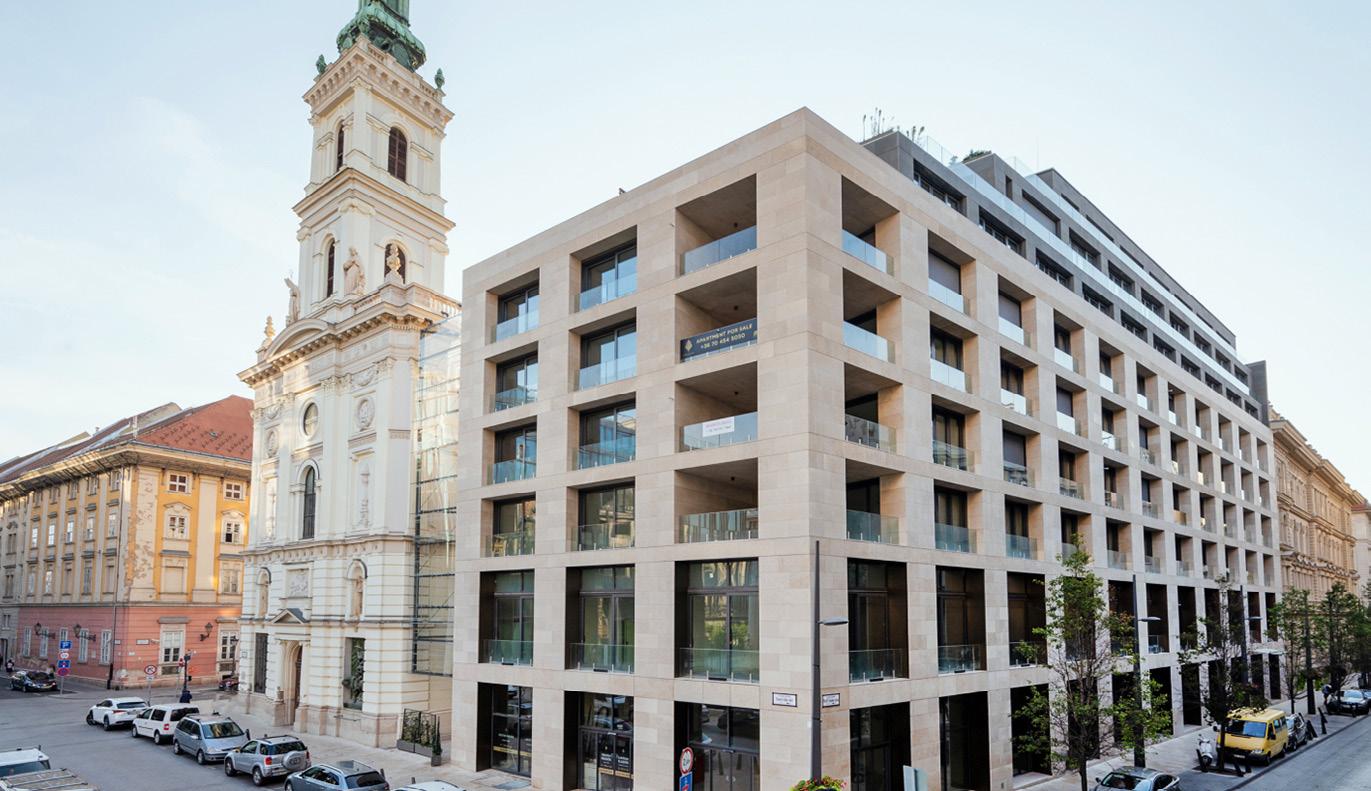




Mátyás Gereben MRICS Country manager
CPI Hungary

Due to the current economic turmoil, 2025 will remain a challenging year for the Hungarian capital markets. However, I am positive that investor interest will pick up in the second half of next year. The logistics sector remains popular, but we are experiencing increasing interest in office buildings that can be converted into hotels or residential properties.
Currently, the ratio of investment activity is 80% by domestic investors, 15% international and 5% CEE investors. International investors are likely to return if there is a reduction in the country risk associated with Hungary and more favorable financing conditions. With regard to yields, I do not anticipate a significant yield correction this year.
ESG issues will not have a huge impact on investments; however, I believe they will significantly influence the financing side of the market. Banks are imposing increasingly strict sustainability requirements for their loans, which can even affect loan margins. I can only hope that finance will become available on more favorable terms. However, that will not impact pre-lease requirements, which will remain above 60-70%.
It is becoming increasingly understood that the least ESGfriendly action a developer can take is to construct a new building. As a result, I expect that new developments will have to meet very high ESG standards, and developers will increasingly focus on refurbishment projects. Within a few years, no new projects will even reach the permitting phase without proper sustainability accreditation, and I fully agree with this approach.
Kata Mazsaroff Managing director Colliers Hungary

We assume an upturn in investment volume activity in 2025, partially attributable to transactions carried over from 2024 and partially to interest rates (and therefore financing costs) continuing to decline, hence becoming gradually attractive to institutional investors despite the stagnation of current real estate yields.
Even with reserved interest in offices, we foresee five or more office transactions to conclude in the coming months. The industrial sector continues to remain attractive, and we expect transactions in the retail and hotel segments due to increased disposable incomes and the revival of tourism. In 2024, domestic capital accounted for around 80% of total investments in Hungary, and the remaining international capital originated from Austria and Germany, with no inflow from the CEE region. In 2025, considering the ongoing transactions and pipeline activity, we expect a higher percentage of regional and international capital compared to the previous year. Still, domestic capital will retain the highest share. One of the drivers for global investors to return to Hungary in larger volumes could be a yield premium compared to Western Europe and other CEE countries. Investors, particularly institutional ones (such as pension funds and insurance companies), have been prioritizing ESG-aligned real estate assets. The EU taxonomy sets strict sustainability criteria, classifying investments as environmentally sustainable if they meet energy efficiency, emissions reduction, and climate resilience standards. Non-compliant assets may face devaluation, stranded asset risk, or lower investor interest. Besides this, ESG-aligned real estate assets often lead to higher rents, occupancy rates, and resale values.
Speculative office development in Budapest continues to fall as developers exercise caution in their strategies. Few new projects are being initiated in the uncertain geopolitical environment, not helped by questions over long-term demand and, critically with regard to putting spades in the ground, concerns over the cost of finance. The market is seen as favorable to developers that can self-finance; otherwise, significant preleases are needed before a project can proceed. That said, established players continue a limited number of large multi-phased projects.
By Gary J. Morrell
The limited number of speculative office projects in the pipeline is predicted to result in a low supply of quality, well-located offices that conform to ESG expectations and regulations and tenant demands. Further a widening gap is evident between high-end offices and class “B,” non-centrally located and non-ESG compliant office space, which has much higher availability. New developments must be designed to comply with increasingly allembracing ESG rules and staff demands to attract tenants successfully. Only the best-designed, most sustainable and well-located office developments will be successful in this demanding office market environment, whether in Hungary or the wider CEE.
“Preleasing is essential and critical, especially in office developments, where speculative projects face higher risks,” comments Valter Kalaus, managing partner of Newmark VLK Hungary.
“Financing is crucial, and most banks require a 45% to 50% prelease for an office development. Securing sufficient

The Liget Center complex by Wing has three elements: the all-new Liget Center Vitrum, the 70-year-old renovated Liget Center Auditorium, and the Liget Center Classic (pictured), which faces Városliget. The last two elements now provide a home to the TV company RTL Hungary.
preleases for each phase is crucial to avoid financial strain,” he adds. Mátyás Gereben, the country manager at CPI Hungary, puts the figure even higher, saying prelease requirements can be as much as 60-70%.
The Budapest office market is the second largest in Central and Eastern Europe, with an average annual demand of about 500,000 sqm. Although leasing activity remained stable in 2024, 57% of this figure came from renewal, reshaping
the take-up structure, according to Cushman & Wakefield. “Budapest has demonstrated a strong recovery with leasing activity growing 8% year-overyear in 2024, exceeding 500,000 sqm, the fourth successive year of growth. With demand surpassing the 10-year average by 7%, Budapest continues to attract and retain occupiers despite broader global market shifts,” says the consultancy.
Continued on page 18
Interior issues related to design, layout, amenities and building management are an intrinsic element of the development cycle of an office project. They are evolving in reaction to tenant demands, increasingly stringent EU regulations, and ESG expectations from all stakeholders.
By Gary J. Morrell
As developers strive to deliver ever more interestingly designed, highly specified and sustainable offices, interior and exterior design, once handled separately, have become part of the same design process. Leading Hungarian and international architects and interior designers are being hired to deliver ever more imaginative projects. Further, accreditation from an independent, third-party sustainability organization such as the U.K.-based Breeam or the U.S.-based Leed, and increasingly, Well, come with a range of requirements. Such certifications
are now the norm for an office development and a basic expectation from tenants, staff and investors.
Sustainability requirements and workers’ demands cover issues as wide-ranging as the office environment, layout and design, the provision of amenities and even the well-being of staff, as this tends to lead to increased productivity and longer retention of employees. How costs are divided between landlords and tenants is something that tends to shift. However, it is argued that high-quality ESG-compliant space is economically beneficial in the longer term for office asset owners.
“Numerous companies have shifted their

focus from older office buildings to newer ones in pursuit of more environmentally conscious, energy-efficient and employee-centric environments,” notes the consultancy Colliers.
Regina Kurucz, managing director of Rewell Consulting, says there is an expectation that people are more conscious about the connection between the built environment and their personal health, and this itself puts pressure on developers to up their game. “However, I do not think we are at a point where all new development adheres to ESG, EU taxonomy and sustainability accreditations. Currently, only the best developments and leading companies have certified venues and portfolios,” she says.
A hybrid work model, whereby employees are offered a combination of in-office and remote days, is increasingly the norm in modern office complexes. Such work practices ensure high ESG standards and help improve productivity by enhancing staff satisfaction. However, a growing number of firms have begun to demand that workers spend more time in the office. As a result, the hybrid model that took hold after the pandemic has mostly settled into a 3:2 ratio in favor of the corporate office. Even so, some employers are thinking about a full return to the corporate office.
“Office interiors need to reflect hybrid office working habits to ensure physical space beyond the traditional work settings for brainstorming, innovation and a platform to establish culture and values,” says Kata Mazsaroff, managing director of Colliers Hungary
The recruitment and retention of the workforce has become a more critical issue in a tight labor market, and providing a healthy and aesthetically appealing atmosphere has become a significant factor in achieving that. Employees prefer to work in a hybrid model and often expect flexibility in working hours and the ability to choose
Location is ever more central to a successful office project. Schemes must be developed in an area that provides for the needs of staff who can access the building by car, public transport or bicycle within a reasonable period.
At the same time, the location should provide visibility for the tenant and conform to increasingly all-embracing ESG expectations and regulations.
By Gary J. Morrell
Budapest has several defined business districts spread across the city on both the Buda and Pest sides of the river and a relatively limited number of office outlets in the Central Business District, reflecting the lack of development plots in the UNESCO-protected heart of the city. One byproduct of that is that Budapest lacks a CBD dominated by high-rise towers, as is the case with many European capitals. Development possibilities do exist in the historic center through the renovation of turn-of-the-century Central European palaces into ESG-compliant offices that meet contemporary expectations. But even here, suitably sized buildings can be difficult to source, and the development process is protracted given the number of heritage-related permissions required.
As ESG issues move to the fore with regard to location, areas with direct access to amenities and services have become a necessity for developers. The conventional wisdom is that staff who often work flexible hours prefer to be based in areas that are well-integrated into the city so they can utilize their surroundings before or after work or on their breaks.
“Location is key; the office should be easily accessible, and its design should be tailored to the needs of the people working there, providing the right conditions for efficient working,” comments Valter Kalaus, managing

partner at Newmark VLK. “Today, it is also a natural expectation that you should not have to travel long distances to reach services such as restaurants, cafés and shopping facilities during a break or after work. Proximity to a gym or beauty salon or barber shop can be an added advantage,” he notes.
There are generally considered to be eight office submarkets spread across Budapest. Non-Central Pest currently has the largest office pipeline due to the approximately 150,000 sqm of owneroccupied space under construction at the
Zugló City Center development in District XIV. This is closely followed by what have traditionally been the leading office submarkets, the Váci Corridor (in Pest’s District XIII) and South Buda (District XI).
“Companies prefer to move from older lower category office buildings in suburban or outer districts to more centrally located modern ESG-compliant buildings. In these central districts, companies recognize that being in close proximity to various services and with improved transportation can better cater to the needs of their employees,” says
The industrial and logistics sector has been booming, with leading Central and Eastern European regional park developers and operators and Hungarian players active. The market has grown on the back of rising logistics demand and the need for space to meet the significant foreign direct investment, notably in the electric vehicle and EV-related industries.
By Gary J. Morrell
The market continues to thrive despite concerns of moderating demand expressed by some analysts, notably in the logistics segment. Experts see fewer speculative development starts in the Greater Budapest area, while built-to-suit projects, particularly in the production sector, are expected to gain momentum. That is notably so in critical provincial locations across the country, where they facilitate regional business and economic development, particularly in the east and south of Hungary.
All industrial developers at the higher end of the market are developing more highly-specified and sustainable industrial and logistics spaces in line with market demands and ESG-related expectations and regulations.
“The demand shift is nuanced. While speculative demand has slowed slightly in some areas, built-to-suit projects remain strong, and there is a continued push for energy-efficient, well-located spaces,” comments Zsuzsanna Hunyadi, director of leasing and customer relations at Prologis Hungary. “Demand for high-quality industrial and logistics spaces remains solid. Nearshoring and the reshuffling of global supply chains continue to drive interest, even if economic uncertainty has made some customers more cautious. What we are seeing is that, right now, the industry
players are following a calm, steady ‘wait and see’ strategy, and I think this mentality will dominate the first two quarters. Growth is now mainly about optimizing costs,” she adds.
Last year saw nearly 500,000 sqm of industrial completions in Hungary, according to consultancy CBRE. Robust occupancy has resulted in an overall vacancy of 7.6%. New construction is slowing, although the 2025 pipeline forecast is still 314,000 sqm in the countryside and 144,000 sqm for Greater Budapest.
There is now more than 5.5 million sqm plus of modern logistics and industrial space in Hungary, with 3.7 million sqm in the Greater Budapest area and the remaining 1.8 million sqm in provincial
centers, according to the Budapest Research Forum (which consists of CBRE, Colliers, Cushman & Wakefield, Eston International, iO Partners and Robertson Hungary).
BUDAPEST BIAS
Cushman & Wakefield has traced a pipeline of 318,000 sqm for Greater Budapest, due to be completed by the end of 2026. CTP, HelloParks and Prologis are the three dominant industrial landlords. Around 70% of modern industrial and logistics facilities are concentrated in Greater Budapest, predominantly along the M0 ring road, with a 6.8% vacancy. Speculative development in Greater Budapest is expected to decelerate as developers take a more cautious approach to mitigate the risk of oversupply.
“The industrial market is thriving, fueled by Tier 1 and 2 suppliers and third-party logistics operators supporting Hungary’s strong industrial base. Regional hubs such as Debrecen, Kecskemét, and Szeged are benefiting from this trend, largely driven by demand from Asian investors and the electric vehicle supply chain.”
The residential sector is once again being seen as an attractive development option, with demand driven by a broader economic recovery and governmentl measures to increase housing supply in Hungary. The number of sites visible across Hungary is a sign that the development of multi-unit residential projects is going through a surge.

By Gary J. Morrell
The residential sector is expected to see further growth, although the number of new apartments delivered in 2024 at around 13,000 saw a fall in yearon-year supply. Low supply combined with growing demand has resulted in prices rising, and the sector is attracting investors. With the housing stock in Budapest under strain, there are
concerns over the growing affordability gap, as is the case across Europe.
In 2025, the number of available apartments in Budapest is expected to decrease. Many properties, especially older ones, are in poor condition, with overcrowding and sub-standard living conditions, according to Petra Demetrovits, sales director at the leading residential developer, Biggeorge Property.
“New housing completions for Hungary have dropped significantly, with only 14,000 homes built in 2023 compared to 28,000 in 2020; 2025 seems to be a promising year, and we can see an increase in demand from the end of 2024,” Demetrovits says.
“The EUR 200 billion Housing Capital Program initiated by the National Economy Ministry aims at increasing annual completions to 25,000 homes.
The hotel and hospitality sector is regarded as an increasingly attractive development and investment option. Budapest and other leading Central European cities are popular tourist destinations, with guest visits rising towards record pre-pandemic highs in Budapest.

By Gary J. Morrell
Despite the perceived complexities of hotel development compared to more established market sectors like office or industrial, where income can be achieved through long-term leases, hotel and hospitality is successfully attracting developers and investors across from those commercial property segments. It
is a reflection of the popularity of the field that Hungarian developers and investors are concluding long-term leases or franchise partnerships with leading branded international hotel operators, who provide the expertise needed for the day-to-day operation of the assets. Although several hotel projects have been put on hold or are subject to delays due to the complexities of development,
concerns over the cost of capital and rising construction and operational costs, there is still a significant hotel pipeline for Budapest and international brands entering the market for the first time.
“I think that in 2025, profitability will be back to pre-pandemic levels. Demand is strongly back, developments have started, and there are also investor inquiries
Retail and shopping center development remains constrained in Hungary due to concerns over the economic environment, spending power, and the increasing spread of e-commerce; no major shopping center projects are in the pipeline.

By Gary J. Morrell
Center owners are essentially concerned with redeveloping and upgrading their properties’ retail, leisure and service mix to meet ever more sophisticated consumer demands. Finding ways to enhance the retail experience is the order of the day.
Modern consumer (and therefore tenant) demands include an improved food and beverage offering, a more varied tenant mix and more imaginatively designed centers.
Retail demand has been under considerable pressure, with e-commerce and high inflation impacting retail
spending. Operational costs present continuing problems for retailers as many center owners pass on increasing energy prices to tenants, for example. The limited ongoing retail development that is being undertaken is almost exclusively as street-level retail and service outlets in larger mixed-use
Real estate professionals and analysts are looking for an upturn in the investment markets this year, with international investors already returning to some parts of Central and Eastern Europe. At the same time, developers and asset owners need to incorporate ESG features and processes into assets to attract buyers, as this has become a basic requirement for the possibility of an exit strategy.
By Gary J. Morrell
From a development perspective, there is a strong pipeline in the industrial sector in both the Greater Budapest area and provincial hubs. Retail (notably retail parks) is regarded positively, and the residential sector is increasingly seen as an attractive option with strong demand for product. Although the office market is currently not in favor with investors across the region, and asset owners are reluctant to exit in the current pricing environment, there are possibilities with the purchase of older assets and overhauling them to bring them up to ESG-compliant standards. An increasingly popular investment vehicle is purchasing a classic heritage building in the historic center of Budapest and redeveloping it into a hotel, residential, or office complex.
Kata Mazsaroff, managing director of Colliers Hungary, anticipates five or more office transactions will be concluded in the coming months, says the industrial sector continues to remain attractive, and adds that transactions in the retail and hotel segments are expected as a result of increased disposable incomes and the revival of tourism.
From a development perspective, there is a strong pipeline in the industrial, hotel and residential sectors, while speculative development in the office and retail sectors is expected to remain constrained. Experts expect EUR 700 million-800 mln
of real estate investment this year, up substantially from the EUR 300 mln recorded in 2024, according to CBRE.
Benjamin Perez Ellischewitz, principal at Avison Young Hungary, is less optimistic and expects around EUR 500 mln plus investment volume for the year. Meanwhile, Mike Edwards, director of capital markets at Cushman & Wakefield Hungary, expects EUR 500 mln in the first half of 2025.
“For Hungary to regain attention, a clear demonstration of liquidity is needed to boost investor confidence and stimulate more activity,” says Cushman & Wakefield.
The broader CEE market experienced a remarkable recovery in 2024, with a total investment volume reaching EUR 8.5 billion, representing an impressive 74% year-on-year increase, according to Cushman & Wakefield. However, Hungary fell to its lowest volume level since 2012.
Poland continued to dominate investment in the region with 58% of the total volume, followed by the Czech Republic at 17%. The question remains: when will there be an upturn in investment activity in Hungary?
“Hungary’s investment market remained subdued in 2024 with an annual transaction volume of EUR 387 mln, reminiscent of post-Great Financial Crisis levels. The absence of large-scale deals weighed heavily on overall market performances, with most activity in assets valued under EUR 30 mln,” says Cushman & Wakefield. The investment market is expected to see improvement by mid-2025 in the view of some analysts, depending on interest rate stabilization, economic conditions, and investor confidence. The industrial and logistics sector is expected to be the most active, followed by retail parks and select office properties with strong ESG
“Hungary’s investment market remained subdued in 2024 with an annual transaction volume of EUR 387 mln, reminiscent of postGreat Financial Crisis levels. The absence of large-scale deals weighed heavily on overall market performances, with most activity in assets valued under EUR 30 mln.”
The term ESG has become increasingly prominent in the business, economic, social and political environment. Essentially, it takes a holistic position that sustainability extends beyond exclusively environmental issues and includes the well-being of staff, customers and consumers in any real estate project.
By Gary J. Morrell
The EU taxonomy, meanwhile, is a classification system that aims to clarify which economic activities are environmentally sustainable in the context of the European Green Deal. The aim is to prevent “greenwashing” and to help investors make informed, sustainable investment decisions. ESG compliance is now the norm in higherend real estate projects and across property and investment business processes. There is also a regulatory expectation from the European Union and national governments. As a concept, it applies throughout a project’s life cycle, from planning, permitting and financing to construction, leasing, project and facility management, and an exit via a sale to an investor. Therefore, all real estate market actors are now impacted by ESG issues and must adapt to increasingly all-embracing regulations.
Overall, the evolution of ESG will likely be driven by a combination of market forces, regulatory developments, and
societal expectations for corporate responsibility and sustainability. Companies and investors that can adapt to these changes and demonstrate genuine commitment to ESG principles are likely betterpositioned for long-term success, says Zsombor Barta, founding partner at independent sustainability consultancy Greenbors.
The second phase of Skanska’s H2Office project, started in late 2024, is a prime example of an ESG-compliant development and is, the developer says, a reflection of its commitment to sustainability at the local level.
The firm aims to achieve net-zero emissions by 2045 across its operations and development-related processes.
“The building will be carbon-neutral in its operations, a clear milestone on Skanska’s journey towards net-zero emissions by 2045. The development incorporates renewable energy technologies, efficient resource management, and community-focused spaces,” says the firm. “The Budapest project highlights how Skanska translates its global sustainability goals into tangible local action. […] In 2024, the company reduced its direct operational carbon emissions by 61% compared to 2015, while emissions linked to development and construction activities decreased by 37% from 2020 levels. All our investments in Hungary undergo Leed, Well Core & Shell, and Access4you certification processes, confirming their compliance with the principles of sustainable development, optimal energy consumption, as well as a safe, comfortable and creative work environment,” the developer adds.
“With the second building of H2Offices, we […] will be using low-carbon construction materials such as concrete, steel, and glass structures. At the same time, we are assuring carbon neutrality during operation by four season heat pumps, secured by on-site energy production with the help of the photovoltaic panels installed on the roof, and [will] purchase 100% electricity from renewable sources,” says András Ábrahám, project director at Skanska commercial development business unit.
“On the demand side, tenant and buyer expectations have shifted towards ESG. Consequently, a time will come when it will be impossible to finance, sell, or rent a building without meeting ESG requirements.”
Budapest must crack the conundrum of preserving its classical turn-of-thecentury Central European look and atmosphere while developing and promoting its role as a modern business center and a tourist destination, as well as making it a comfortable, pleasing and healthy place to live, work and visit.
By Gary J. Morrell
Developers also face the (admittedly not unique to Budapest) challenges of developing in accordance with ever stricter environmental regulations, EU taxonomy and locational demands from tenants and customers, and an increasing scarcity of development sites in appropriate areas for such developments.
“The city needs improved public transport, smart city initiatives, green spaces, and urban regeneration projects to maintain its appeal as a business and tourism hub. We can see some great initiatives, but a better coordination effort might contribute to a more successful master plan,” comments Valter Kalaus, managing partner of Newmark VLK Hungary.
“The EU taxonomy exerts an influence from a regulatory and market demand perspective on architecture; this encourages cities to align local regulations with EU taxonomy standards, promoting uniformity in sustainability practices across the EU,” notes Zsombor Barta, the founder of Greenbors Consulting. “Market competitiveness enhances cities that prioritize sustainable development, attracting businesses and residents seeking environmentally responsible living and working environments. This improves the overall urban quality of life through greener infrastructure, better air quality, and increased green spaces,” he argues.

“These regulatory pressures could result in higher quality and more ESG-compliant buildings being produced. This approach enhances environmental sustainability, fosters social responsibility, and ensures strong governance, benefiting investors, developers, owners, tenants, staff, and the wider community by creating resilient, inclusive, and high-performing real estate assets,” the expert believes.
Barta says the EU taxonomy will influence architecture and urban development in Budapest and other cities by setting clear criteria for what constitutes sustainable building practices, leading to more eco-friendly and energyefficient buildings. The requirements will guide investors towards projects that meet specific environmental criteria, channeling funds into sustainable urban
development. “Innovation and technology stimulate the adoption of innovative technologies and materials that reduce carbon footprints and enhance building performance,” he adds.
All phases of the development process are thoroughly impacted by EU taxonomy and ESG expectations, according to Péter Kocsis, deputy CEO for strategy, risk and management information system data at developer Wing. “This process itself can also be ESG conscious when using BIM [building information modeling] planning tools and extensive financial modeling solutions,” he says.
In the process, it brings together issues such as the function, size (is it in harmony with its environment), layout (incorporating open, collaborative space, natural light, and amenities), location,